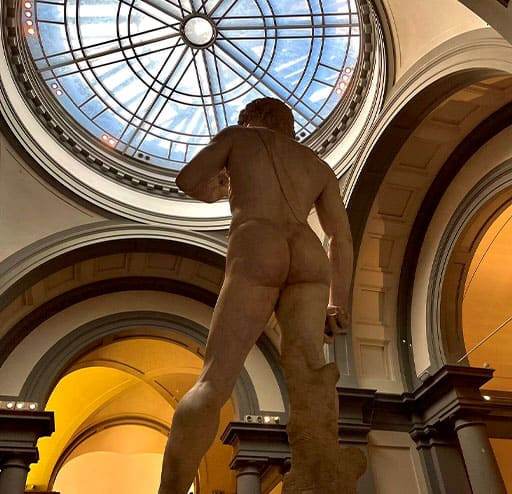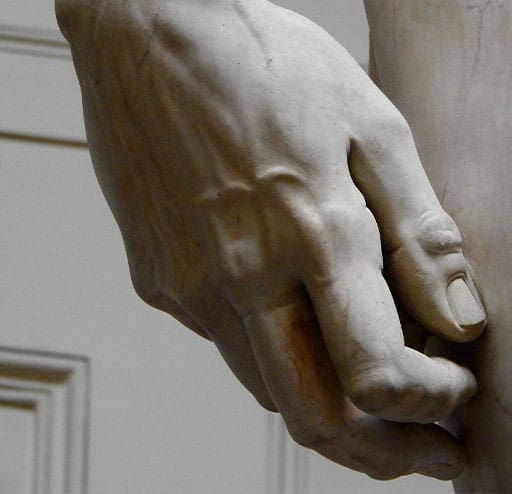the statue of david by michelangelo
The statue of david by michelangelo: David is a marble sculpture by Michelangelo, executed between 1501 and 1504.
There is no doubt that this is the most famous and beautiful sculpture in the world. Among the most iconic Renaissance works of art in Italy, the statue of David stands over 5 meters tall and attracts millions of tourists every year.
The massive block of white marble used in the construction of this sculpture came from the Apuan Alps in Carrara. This is a town in Northern Tuscany. The stone was initially intended as a crown for the Church. However, Michelangelo transformed it into a magnificent statue in 1501. In 1504, the David was placed in Piazza della Signoria, right next to the Palazzo Vecchio. In 1873, it was moved to the Accademia Gallery after residing there for 350 years.
Florence – A towering giant, standing five meters tall, monumental with its over five tons of Carrara marble, naked, armed only with a sling and a stone, with a proud gaze challenging the enemy, muscles exuding courage, it looms in a room at the Accademia Gallery in Florence.
We’re talking about the David that Michelangelo Buonarroti chose to place in front of the Palazzo della Signoria after a strenuous and adventurous transport through the streets of Florence, symbolizing freedom against the powerful enemies of the time. And today, over 500 years later, it can make the struggle against a common enemy feel less bitter.
Who was commissioned to sculpt the statue before Buonarroti?
Initially, in 1464, the task of sculpting a giant standing over 5 meters tall, with the marble brought to Florence by boat through the Arno River from a quarry in Carrara, was entrusted to Agostino di Tuccio. However, shortly after starting the work, he abandoned the project. 1476 the commission passed to Antonio Rossellino, but it remained unfinished.
Approximately 40 years later, on August 16, 1501, the consuls of the Guild of Wool and the Opera del Duomo of Florence commissioned the work to a Michelangelo who was just over twenty-five years old, offering him a compensation of 400 ducats. Buonarroti accepted the challenge, taking on the damaged block that was “poorly roughed out and sculpted.”
After the statue was declared “almost finished” on January 25, 1504, a commission composed of the greatest artists of the time (including Leonardo da Vinci, Sandro Botticelli, Filippino Lippi, and the Perugino) decided that the sculpture should be placed at the entrance of Palazzo Vecchio as a symbol of the strength and independence of the Florentines.
The sculpture embodied the concept of the just, armed only with a sling and faith in God, prevailing over the powerful but unjust. This image could be associated with good governance, ensuring freedom and the common good.
On September 8, 1504, the sculpture was presented to the city, receiving widespread admiration.
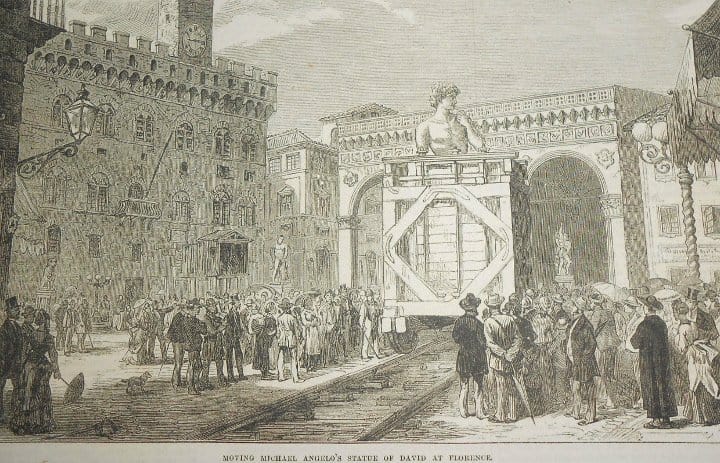
The Gilded David
Initially, certain parts of the David sculpture were gilded: a wreath on the head, the wooden trunk behind the right leg, and the sling. The sculpture, including its sculpted base, stood at 517 centimetres and weighed 5560 kilograms. The transportation to the designated location, involving more than forty men, took place over four days.
Michelangelo refined the work on-site by painting the gold wooden trunk behind the right leg and adding brass garlands with gilded copper leaves around the head and sling strap. The statue faced southwest, symbolizing a challenge to the enemy populations ready to attack Florence.
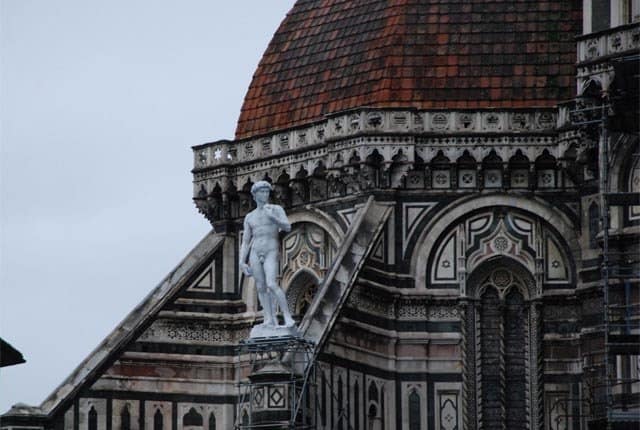
What does the statue of david by michelangelo represent?
The stern expression, the proud and penetrating gaze, and a slight smirk on the lips, perhaps betraying a sense of contempt towards the enemy, allude to the concentration of the hero before the battle. David, the biblical hero, is depicted when he is about to confront Goliath, the Philistine giant. The observer can almost feel the blood coursing through the veins of this young man, gripping the stone in his right hand with which he will defeat the enemy shortly.
Buonarroti breaks with the tradition of depicting David with Goliath’s head at his feet and portraying him as “a gentle-looking youth, with fair hair and beautiful eyes.” It is true that in another passage of the Bible, David declares that he has killed bears and lions with God’s help and has no fear of Goliath. The artist may have considered this testimony during the creation of the work.
The warrior’s pose, with all the weight resting on the right leg, follows the typical contrapposto stance derived from the canon of Polyclitus. Unlike the other two extremities, the right arm and the left leg are relaxed. The athletic body, at the peak of youthful strength, is revealed through meticulous attention to anatomical details, from the twist of the neck traversed by a vein to the structure of the tendons, from the veins on the hands and feet to the muscular tension of the legs, all the way to the perfect musculature of the torso.
To imbue his masterpiece with expressiveness, Michelangelo slightly enlarges the head – symbolizing reason – and the hands – the tool through which reason acts – harmoniously perfected from the privileged view from below.
The Myth of David
“…and truly, this work has silenced the acclaim for all modern and ancient statues, whether Greek or Latin, because in it, there are beautifully contoured legs, divine curves and slender hips; never before has such a sweet pose or grace been seen, nor feet, nor hands, nor a head that matches each of its parts in artistry, equality, and harmony of design. Indeed, anyone who sees this should not bother to look at any other sculpture made in our times or in any other period by any artist.”
As Vasari’s words suggest, the David was widely admired, and its success was immediate. The statue embodied all the ideals of the Renaissance. Its virile, powerful, and harmonious forms became an expression of a complex set of philosophical and aesthetic values. The Florentines identified with the athletic and proud appearance of the young hero, interpreting it as a symbol of the strength and power of the city at the height of its glory.
From the broken arm to the broken finger: the vicissitudes of the “giant.”
In 1512, while the statue was still in front of the Palazzo della Signoria, lightning struck it. The cracks, indicating signs of instability, appeared around the ankles, causing concern, but ultimately no significant damage occurred. On April 26, 1527, during the third expulsion of the Medici from Florence, David was hit by thrown stones, furniture, and roof tiles from a group of Republicans barricaded in Palazzo Vecchio. The statue’s left arm broke into three pieces, and the sling, at shoulder height, was chipped.
Giorgio Vasari and Francesco Salviati, devoted admirers of Michelangelo, collected and hid the fragments in Salviati’s house. With the return of Grand Duke Cosimo I, restoration work was carried out.
In 1813, the middle finger of the right hand was reconstructed due to damage. In 1843, sculptor Lorenzo Bartolini, director of the “Regie Fabbriche,” commissioned Aristodemo Costoli to restore the statue. Using hydrochloric acid and sharp tools to remove surface crusts, this intervention proved disastrous and caused irreparable damage to the marble’s surface.
On August 29, 1846, founder Clemente Papi made a plaster cast that would serve as the base for the future bronze casting of the replica, which is currently located in Piazzale Michelangelo, overlooking Florence.
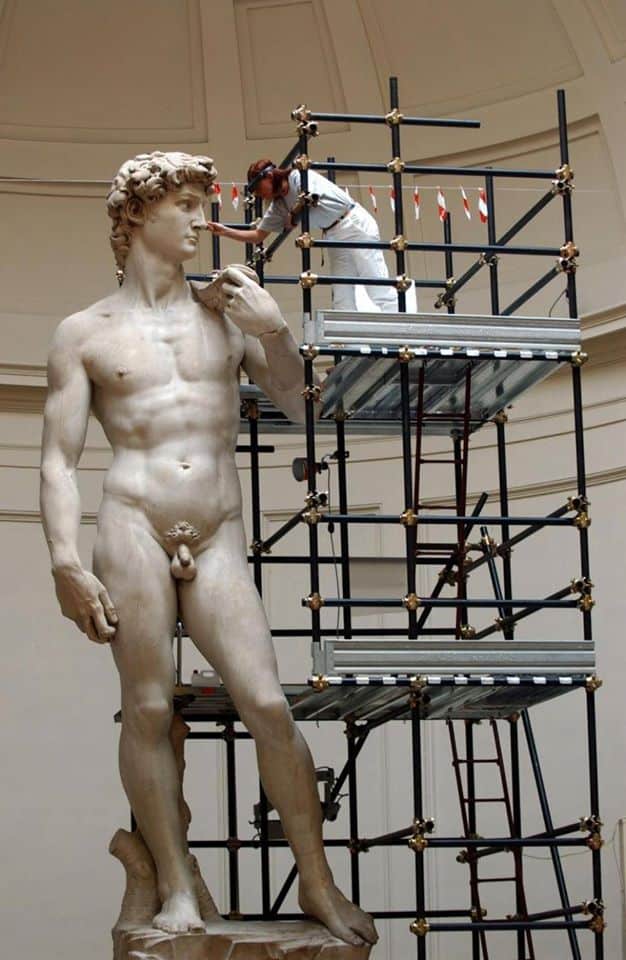
In more recent times 1991, a deranged individual damaged the statue with a hammer. The big toe and the first two fingers of the left foot were chipped. Still, the missing parts were reintegrated using original fragments and numerous existing casts, restoring the cavity to its original appearance.
“In 1872, due to the precarious conservation conditions, it was decided to transfer the statue to the Accademia Gallery in Florence. The architect Emilio De Fabris was tasked with building a new showcase placed scenographically at the end of the Gallery of Ancient Paintings, with its lighting provided from above by a skylight. In August 1873, the statue was harnessed onto a wooden cart and, sliding on rails through the city centre streets, arrived at the Accademia accompanied by public acclaim.
However, the David remained enclosed in its crate at the museum for nine years, awaiting the completion of the showcase. Only in 1875, during the celebrations of the fourth centenary of the artist’s birth, was the sculpture unpacked for an exhibition featuring plaster reproductions of the sculptural masterpieces.
On July 22, 1882, the Michelangelo Museum was finally inaugurated, and the statue was made accessible to the public. In Piazza della Signoria, in 1910, a copy of the David was placed, created by sculptor Luigi Arrighetti, winner of a specific competition held for its realization.”
The statue of david by michelangelo and the anecdote of nose
There is no shortage of anecdotes and curiosities surrounding Michelangelo’s masterpiece. One of the most amusing ones involves Pier Soderini, who, as the gonfalonier of Florence, was the first to inspect the sculpture.
After observing it for a long time, he exclaimed, “Well, it’s beautiful… But that nose… Did you make it too big?”
According to legend, Michelangelo sighed, picked up some marble dust from the ground, climbed up the ladder, and pretended to tap his nose, causing the dust to fall above. In this way, he fooled Soderini into thinking he had modified David’s face.
“Is it better like this?” he asked after finishing. “Ah yes, yes,” replied the satisfied Soderini. “Now it’s absolutely perfect!”
This amusing anecdote, more legend than truth, is nevertheless illustrative of Michelangelo’s character, as he would never have accepted to modify anything in his work at someone else’s request.
all the copies of statue of david in the world
Around 1870, there was a growing belief that Michelangelo’s work should be preserved inside the walls of a museum, and Clemente Papi was commissioned to create a copy of David to be placed in Piazza della Signoria. While the artist was forging his bronze David, workers built a carriage to transport the original to the Accademia Gallery. It took five scorching days in August 1873 to complete the operation!
David arrived at the Accademia without any damage, where we can still admire it in all its splendour today. And what about the copy in Piazza della Signoria?
The Florentines strongly criticized Papi’s bronze copy because it was not faithful to the original. As a result, it was moved to Piazzale Michelangelo, along with the bronze copies of Night, Day, Twilight, and Dawn from the Medici Chapels.
Piazza della Signoria remained without its iconic symbol for several years until the early 1900s when the second marble copy, created by Luigi Arrighetti, was placed there. Have you ever wondered how many copies of David have been made throughout history?
Excluding all those sold in souvenir shops, there are 16 1:1 copies of this extraordinary sculpture. They are scattered worldwide: in London, Copenhagen, Antwerp, Los Angeles, Las Vegas, Philadelphia, California, Australia, and India…
Pictures of the statue of david by michelangelo
Learn more about the statue of david by michelangelo
Here are 10 things you should know about the statue of david by michelangelo
Based on what historical figure was Michelangelo’s David modelled after?
In this sculpture, Michelangelo drew inspiration from the Biblical tale of David, a shepherd boy who slew a giant with just a sling and a handful of stones to save the Israelites.
What was the purpose of Michelangelo’s creation of David?
In his early twenties when he was commissioned to create a statue representing the biblical hero David, Michelangelo Buonarroti (1475 – 1564) was in his early twenties when he was commissioned to create this statue. An offer was made to him to work on a colossal block of marble which had previously been carved by two other artists, Agostino di Duccio (in 1464) and Antonio Rossellino (in 1475).
Is there a reason for David’s hand to be so big?
Despite Michelangelo’s mastery of human anatomy, David still possesses a few anatomical defects that may be attributed to him. It has been suggested that the right-hand features an enlarged abductor digit minimi in order to draw attention to the stone as a symbol of his courage and physical strength than the left hand.
What is David holding in his left hand?
In the Bible, the Bible tells us that when David went to fight Goliath he took his shepherd’s staff, five smooth stones, and his sling with him. There are two kinds of slings, and only the latter is represented in Michelangelo’s sculpture, as David holds the pouch of the sling with his left hand, above his shoulder, as shown in the sculpture.
What happened to David’s toes?
Michelangelo’s David, probably the most famous sculpture in the world, has been damaged in a Florence museum today when a man who police describe as being deranged broke a part of a toe with a hammer, claiming that a 16th-century Venetian painter’s model instructed him to do so.
Where is the real statue of the David by Michelangelo?
The Galleria dell’Accademia di Firenze, or “Gallery of the Academy of Florence”, is a museum of art that is located in Florence, Italy. One of the most famous sculptures in the world is Michelangelo’s David, which is on display at the museum. There are also other sculptures by Michelangelo in the museum, as well as a large collection of paintings by Florentine artists, most of which date from the period from 1300 to 1600.

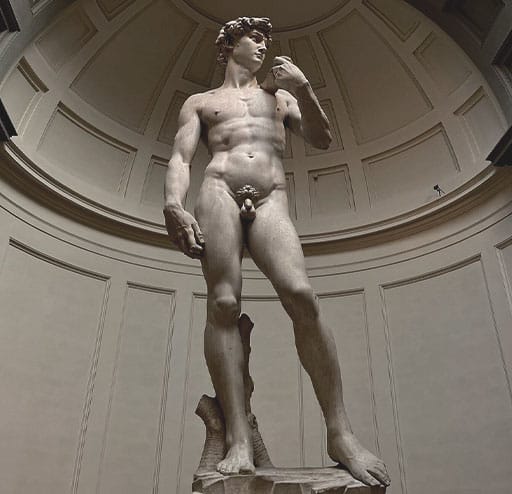


How tall is the statue of david by michelangelo?
His height of David is 5.16 meters (nearly 17 feet, which is a bit short at 16 feet and 11.15 inches).
Are there two statues of David?
Currently, there are three statues of David within the Vatican that maintain Michelangelo’s visionary sculpting and are one authentic statue and two replica statues.
Why is David the symbol of Florence?
This David is the symbol of the fight that the Florentines waged against the Medici and they adopted it as their own symbol. The cathedral authorities decided in 1504 that Michelangelo’s creation was too majestic to be placed so high up on the structure. As a result, it was relocated to a much more convenient place, near the Palazzo della Signoria, the main square in the city, than its previous location.
How did David influence the Renaissance?
As with Michelangelo’s earlier masterpiece Pieta (1498-9) he had just completed in Rome for Saint Peter’s Basilica, the David established Michelangelo (1475-1564) as one of the most brilliant Renaissance sculptors of the early Cinquecento era, and one of the only serious rivals of the Florentine Leonardo da Vinci (1452-1519) during this time period.
Accademia Gallery Guided Tours and Tickets for 2024
Links you might find useful
Tickets & Tours
Accademia Gallery
Visitor Information
Opening Hours
Tickets and Tours
Accademia Online
Radio Accademia
Florence Attractions
Uffizi Gallery
Duomo Florence
Palazzo Pitti
More Florence Attractions

